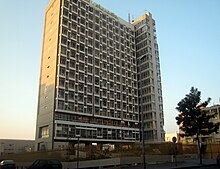Électricité du Liban: Difference between revisions
Enthusiast01 (talk | contribs) No edit summary |
Enthusiast01 (talk | contribs) No edit summary |
||
| Line 1: | Line 1: | ||
{{Expand French|Électricité du Liban|date=January 2020}} |
{{Expand French|Électricité du Liban|date=January 2020}} |
||
[[File:EDL siege.jpg|thumb|EDL corporate headquarters, Beirut]] |
[[File:EDL siege.jpg|thumb|EDL corporate headquarters, Beirut, before destruction in 2020]] |
||
'''Électricité du Liban''' (Electricity of Lebanon, EDL) is a public industrial and commercial establishment in [[Lebanon]] which controls 90% of the country's electricity production, transmission and distribution activities.<ref>{{cite web |url=http://www.edl.gov.lb/AboutEDL.htm|title=About EDL |website=Edl.gov.lb |accessdate=2017-07-29|archive-url=https://web.archive.org/web/20060519022913/http://www.edl.gov.lb/AboutEDL.htm|archive-date=2006-05-19|url-status=dead}}</ref> |
'''Électricité du Liban''' (Electricity of Lebanon, EDL) is a public industrial and commercial establishment in [[Lebanon]] which controls 90% of the country's electricity production, transmission and distribution activities.<ref>{{cite web |url=http://www.edl.gov.lb/AboutEDL.htm|title=About EDL |website=Edl.gov.lb |accessdate=2017-07-29|archive-url=https://web.archive.org/web/20060519022913/http://www.edl.gov.lb/AboutEDL.htm|archive-date=2006-05-19|url-status=dead}}</ref> |
||
Revision as of 11:11, 10 October 2021
You can help expand this article with text translated from the corresponding article in French. (January 2020) Click [show] for important translation instructions.
|

Électricité du Liban (Electricity of Lebanon, EDL) is a public industrial and commercial establishment in Lebanon which controls 90% of the country's electricity production, transmission and distribution activities.[1]
History
1964: Office of Electricity of Lebanon
The Office of Electricity of Lebanon (Électricité du Liban, EDL) was created in July 1964, and was granted a monopoly of the production, transport and distribution of electricity in Lebanon. Until the 1975-1990 Lebanese Civil War, the EDL provided normal distribution, and even distributed electricity to Syria. Until the early 1980s, including the first years of the conflict, the EDL remained profitable and self-financed its development projects.
Crisis since 1990s
In the 1990s the management of the company began to crumble, to the point of getting rid of its accounting department in 2001. When the conflicts emerged, the infrastructures were not upgraded. The number of employees was 5,000 in 1975 and 2,500 in 2009. In 2002, international donors agreed to invest in the electricity sector in Lebanon in exchange for structural changes, that were never made. The 2006 Israeli-Lebanese conflict affected EDL production plants. A daily 3-hour load shedding was implemented.
In June 2010, the Minister of Energy Gebran Bassil announced that from 2014-2015 load shedding will cease by increasing production capacity from 1,685 MW in 2011 to 5,000 MW in 2015. In 2020, however, the reforms were still blocked, and the country's production capacity did not exceed 3,000 MW.
On 4 August 2020, following a huge double explosion at the port of Beirut, EDL's headquarters located near the port was completely destroyed, as well as the control center of the national grid it housed. The explosion caused the death of several people inside the building. Control of the national network was transferred to the Bsalim power station and temporarily carried out manually.[2]
Privatisation
Electricity reform continues to be a major political issue in Lebanon. A law providing for the privatisation of electricity was adopted in 2002, at the initiative of the Hariri government, in connection with the Paris II conference where donors pledged to provide finance to Lebanon on condition of structural reforms. However, this reform was never implemented.
In 2010, Minister Gebran Bassil launched another reform plan focusing on increasing production capacity, and providing for delegating collection and distribution to the private sector, which was done in 2012. The plan provoked daily protests by employees in the sector, 70% of whom (i.e. 2,000 workers) had been made redundant. Controversies over the financing of new investments, the technological options to be favored, the choice of companies, the acceptance of works, the partial privatization of production had considerably delayed the implementation of the plan and cuts remained a daily reality.
See also
References
- ^ "About EDL". Edl.gov.lb. Archived from the original on 2006-05-19. Retrieved 2017-07-29.
- ^ Ghajar : Destruction totale au siège d'EDL, 5 August 2020 (access: 5 January 2021)
